My app uses a dark navigation bar color. Therefore I set the status bar color to white (so it has a nice contrast).
I did this by setting the barStyle to black (to make the status bar white) and also setting the barTint to my dark red color. Works perfectly.
I present a SafariViewController like this:
func openWebsite(urlString: String) {
if let url = NSURL(string: urlString) {
let svc = SFSafariViewController(URL: url)
svc.delegate = self
self.presentViewController(svc, animated: true, completion: nil)
}
}
However the status bar of the presented SafariViewController still is white. This is a problem because the SVC navigation bar has the default white transparent iOS default style. So the status bar is basically invisible.
How can I fix that?


